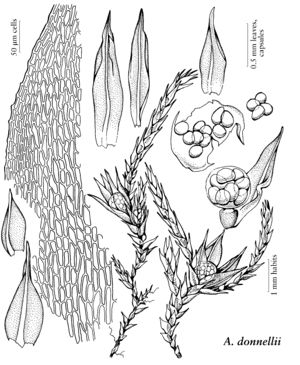Archidium
Bryol. Univ. 1: 747. 1827 ,.
| Taxon | Illustrator ⠉ | |
|---|---|---|
 | Archidium alternifolium | Patricia M. Eckel |
 | Archidium donnellii | Patricia M. Eckel |
 | Archidium minus | Patricia M. Eckel |
Plants mostly green. Stems terete, 1–20 mm. Leaves of distal portions of stems and of perichaetia ovate, ovatelanceolate, linear-lanceolate to triangular, often reduced and distant in proximal portion of stem, flat or somewhat concave, apex acute to acuminate, sometimes incurved or rarely secund, margins plane, recurved or rarely incurved, distal margins smooth to finely serrulate; costa weak and not reaching apex or sometimes absent, to more often strong, single, percurrent to excurrent in a hairpoint; laminal areolation uniform to somewhat differentiated, cells mostly rectangular to rhomboidal, sometimes irregular in median and distal portions, rectangular and rhomboidal cells mixed with short subquadrate cells, alar cells similar to adjacent cells or differentiated, hyaline, wide-rectangular to quadrate. Sexual condition autoicous, paroicous or synoicous, antheridia often naked in axils of distal stem-leaves or outer perichaetial leaves, sometimes enclosed in short-shoots with small leaves (bracts). Perichaetial leaves often larger and more variable in shape than stem-leaves, sometimes broadly ovate to elliptic. Capsule immersed in perichaetial leaves, brown or golden at maturity. Spores spherical to polyhedral, pale-yellow to yellowbrown, golden, orange or red-orange, smooth to finely papillose.
Distribution
Worldwide except Antarctica, in subtropical to warm-temperate regions
Discussion
Species 35 (6 in the flora).
Superficially, species of Archidium can be mistaken for Pleuridium, and many collections of the latter genus have been identified as Archidium. Both genera consist of very small mosses that typically colonize soil in open sites and have ovate-lanceolate to lanceolate leaves, which are often subulate. However, species of Pleuridium have leaves that are often strongly shouldered and long-subulate, a seta, capsules that are typically ovoid (rather than globose) with an apiculate tip, a calyptra, and smaller, more numerous spores. In the descriptions, spore diameters are given for the longest axis (following J. A. Snider 1975).
Selected References
None.
Lower Taxa
Key
| 1 | Plants ephemeral, minute, stems mostly smaller than 3 mm, not branched by sterile innovations; leaves oblong to lanceolate, apex acute, costa weak in perichaetial and distal leaves, not reaching apex, sometimes absent; synoicous | Archidium minus |
| 1 | Plants perennial, larger, stems 2-20 mm, commonly branched by sterile innovations; leaves ovate-lanceolate to ovate, apex mostly acuminate; costa strong, percurrent to excurrent; autoicous or paroicous | > 2 |
| 2 | Paroicous; antheridia typically naked in axes of perichaetial leaves or distal stem leaves below perichaetium, or sometimes 1-2 small bracts present; sporophytes terminal | > 3 |
| 2 | Autoicous; antheridia in leafy axillary buds; sporophytes terminal or lateral | > 4 |
| 3 | Perichaetial leaves mostly erect, plane, with serrulate distal margins, median laminal cells narrow (8-13 µm), elongate-rhomboidal, 6-10:1. | Archidium alternifolium |
| 3 | Perichaetial leaves often spreading, plane to recurved, with smooth distal margins, median laminal cells wide (15-35 µm), short-rhomboidal, 3-5:1. | Archidium tenerrimum |
| 4 | Median laminal cells of distal stem and perichaetial leaves very irregular in shape, from subquadrate to short-rectangular or rhomboidal, intermixed; alar cells not much differentiated from adjacent basal cells | Archidium donnellii |
| 4 | Median laminal cells of distal stem and perichaetial leaves with uniform areolation, either rhomboidal or rectangular, alar cells, especially along margin, quadrate to short-rectangular, differentiated from adjacent basal cells | > 5 |
| 5 | Median cells of perichaetial leaves wide (15-28 µm), distal leaf margins of distal and perichaetial leaves recurved. | Archidium hallii |
| 5 | Median cells of perichaetial leaves narrow (9-15 µm), distal leaf margins of distal and perichaetial leaves plane. | Archidium ohioense |
"um" is not declared as a valid unit of measurement for this property.